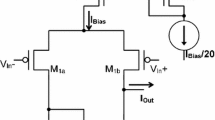Abstract
Design of monolithic low-noise amplifiers in bipolar and CMOS technologies for matching a given signal source is presented. Noise matching conditions are derived for three different types of source impedance, i.e., resistive, capacitive, and inductive. Emphasis is put on the comparison of the best noise performance obtainable by the use of bipolar and CMOS approaches. It is shown that for a resistive source, low-noise amplifiers can easily be designed in both bipolar and CMOS technologies. While for capacitive and inductive sources, a CMOS approach yields better noise performance than a bipolar one. Measurement and simulation results on some amplifiers are presented which confirm the theoretical considerations.
Similar content being viewed by others
References
A. Bilotti and E. Mariani, “Noise characteristics of current mirror sinks/sources,”IEEE J. Solid-State Circuits, vol. SC-10, December 1975, pp. 516–524.
Z.Y. Chang and W. Sansen, “Stability and noise performance of constant transimpedance amplifier with inductive source,”IEEE Trans. Circuits Syst., vol. CAS-35, 1989, pp. 264–271.
Z.Y. Chang and W. Sansen, “Low noise, low distortion AM wide band amplifiers with capacitive sources,”IEEE J. Solid-State Circuits, vol. SC-20, June 1990, pp. 833–840.
G. Erdi, “Amplifier techniques for combining low noise, precision, and high-speed performance,”IEEE J. Solid-State Circuits, vol. SC-16, December 1981, pp. 653–661.
Y. Netzer, “The design of low-noise amplifiers,”Proc. IEEE, vol. 69, no. 6, June 1981, pp. 728–741.
Y. Netzer, “A new interpretation of noise reduction by matching,”Proc. IEEE, vol. 62, March. 1974, pp. 404–406.
A.G. Jordan and N.A. Jordan, “Theory of noise in metal oxide semiconductor devices,”IEEE Trans. Electron. Devices, vol. ED-12, no. 3 March 1965, pp. 148–156.
C.T. Sah, S.Y. Wu, and F.H. Hielscher, “The effects of fixed bulk charge on the thermal noise in metal-oxide-semiconductor transistors,”IEEE Trans. Electron. Devices, vol. ED-13, no. 4, April. 1966, pp. 410–414.
Z.Y. Chang, and W. Sansen,Low-Noise Wide-Band Amplifiers in Bipolar and CMOS Technologies, Norwell, MA, Kluwer Academic Publishers, December 1990.
H.A. Haus et al., “Representation of noise in linear twoports,”Proc. IRE, vol. 48, January 1960, pp. 69–74.
Robert G. Meyer and Robert A. Blauschild, “A wide band low noise monolithic transimpedance amplifier,”IEEE J. Solid-State Circuits, vol. SC-21, no. 4, August 1986, pp. 530–533.
Kiichi Yamashita et al., “A variable transimpedance preamplifier for use in wide-dynamic range optical receiver,”IEEE J. Solid-State Circuits, vol. SC-21, no. 2, April 1986, pp. 324–329.
Ernst H. Nordolt, Henk C. Nauta, and Corlex A. Boon, “A highdynamic range front end for an upconversion car-radio receiver,”IEEE J. Solid-State Circuits vol. SC-20, no. 3, June 1985, pp. 688–696.
Author information
Authors and Affiliations
Rights and permissions
About this article
Cite this article
Steyaert, M., Chang, Z.Y. & Sansen, W. Low-noise monolithic amplifier design: Bipolar versus CMOS. Analog Integr Circ Sig Process 1, 9–19 (1991). https://doi.org/10.1007/BF02151022
Received:
Revised:
Issue Date:
DOI: https://doi.org/10.1007/BF02151022




